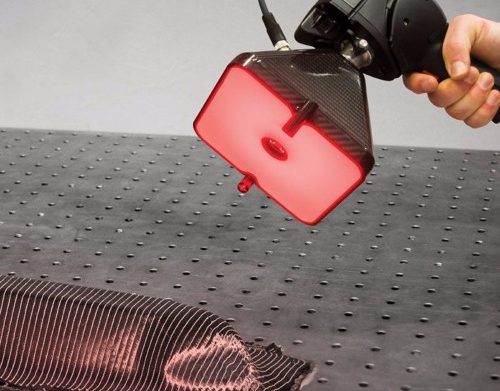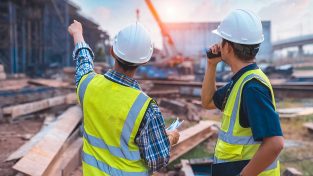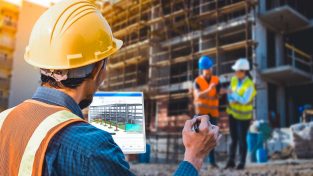BK: Welcome back to HxGN RADIO, my name’s Brian. Thank you for joining us. Lightweight and extremely strong composite materials have been a manufacturing buzzword for some time now. They are already helping our aerospace and automotive OEMs build improved fuel efficiency, and there’s a huge amount of potential for use in other industries as well. Joining me today is Alexander Leutner, the Managing Director of Apodius, the Hexagon-owned composite inspection and solution specialist. In today’s episode, we will be talking about what makes composites so attractive for manufacturers, and why they are so challenging to work with. Alexander, thank you for joining us.
AL: Thank you for inviting me.
BK: Absolutely, it’s great to have you here. So, let’s get started. I’ve got a question for you. What do you mean by a composite material? Let’s start there.
AL: Composite material mainly is a combination of two main components that work together in one part finally.
BK: Makes sense.
AL: So, you have especially fibres, which are taking the load in the part, and you have for example resin that holds everything at its place. You have carbon composites especially, where fibres are made out of carbon.
BK: Okay, that makes sense. Excellent. So, compared to traditional materials, for example, why are composite materials so desirable?
AL: They’re desirable because they are lighter and they have as big a strength in the end as metal. So you can design them holding ready the stiffness and the strength at certain positions, where you really need it to be. You can reduce the thickness, for example, at certain points on the part to save weight.
BK: Mm-hmm, excellent. Okay, that makes sense. You said it’s cheaper. Is it cheaper than traditional materials?
AL: That’s the huge problem and that’s the idea, because… why you need inspection systems here, because the raw material and also the production processes, they are still very expensive.
BK: Mm-hmm.
AL: And this is why you need many inspection systems or processes of inspections at many different stages of production, to make sure that you don’t produce something that is not good, and that has to be, let’s say thrown away in the end.
BK: Understood, okay. So what are some examples of industries where composites are currently being used?
AL: The biggest example would be aerospace, of course, which the North American market is very huge in. Boeing does it a lot, and Airbus, and all their suppliers, of course. The other biggest field is automotive, and this is where we are more or less coming from. Ahead in this branch is BMW, they are located in southern Germany with a huge plant where they achieve the full industrialisation of a large-scale production. For example, they fully produce the project i cars there. It’s the i8 and the i3, which you might have already heard about maybe. They are on our roads, and they are made fully out of carbon fibre.
BK: Interesting, okay. So carbon fibre as opposed to? What would be a material that it used to made out of?
AL: They used, of course, sheet metal.
BK: Sheet metal, okay.
AL: They are having a material mix right now in conventional cars. For example, BMW 7 series, there they have a lot of steel and aluminium I think, and of course carbon fibre, and they are trying to implement more carbon fibre parts to their normal cars.
BK: Excellent. Going along with that, and for those who may not know, BMW using carbon fibre, what’s the advantage? What’s the benefit to doing that?
AL: So the idea is weight saving. You reduce the weight of the car, of the vehicle. It could also be the airplane, to reduce the CO2 emissions, for example. And of course on the other hand, to save fuel, and in the i8 and i3 cars, huge battery packs for example are in the cars, and they are very heavy. So they want to save weight for putting in bigger batteries, for example.
BK: Excellent, understood. Now what about safety with composite materials?
AL: It is very strengthful, maybe? It has a good stiffness, so when you have certain positions or locations on the car, on the body, you can get the full safety that you need. So no problem.
BK: Excellent, all right. Okay, so let’s talk about inspection. What properties of composite materials make inspection difficult, to measure?
AL: It’s especially the fibre itself. So if it’s carbon fibre, you have a black and highly reflective surface. It consumes a lot of light, and at the same time it reflects a lot. So you need to handle these problems, you need a specific illumination for example. If you want to run an image processing system, this is what we actually do. So we have a camera and illumination, we are taking pictures of the surface, and we then check for fibre orientations. Doing so we are able to find defects as well, because defects for us can be a deviation in the fibre orientation, and this is what helps us out here.
BK: Okay, excellent. So why is it important to have knowledge of the fibre orientation?
AL: As I already said, and Norbert showed it very well in his keynote. I don’t know if you’ve seen that. He was using a carbon fibre patch with two directions. One in zero and one in 90 degrees, and if you pull on the fibre in its direction, for example, on zero or into 90 degrees direction, you have the full strength of the fibres, but if you load it for example with a wrong orientation of already five degrees, you can have a loss of strength of the part in the end, of about 50% already.
BK: Okay.
AL: And this is what makes it so important to have the right orientation, and on the other hand, carbon fibre parts these days include a huge safety factor. So they put extra material on these parts to be on the safe side if something goes wrong, that the part doesn’t break. The idea is if you have a better knowledge of your parts and of your fibre orientation, you also gain more understanding of your process for example, or of part simulation for example. And doing so, you can in the end reduce the safety factor, to be able to save weight and material already on the part itself.
BK: Excellent, excellent. So this where your company brings expertise. So tell me a little bit about the sensors that you offer for manufacturers who need to measure the carbon fibre.
AL: We’re mainly using machine vision sensors, so it is optical. We have a camera, and a specific illumination, and we have of course our computer with the software that is running the image processing. This is mainly it, so this is the 2D application. So it is a simple system. It takes a picture and it just gives you an idea of how good is the area that you have been looking on. So people or customers are guiding it to specific positions on the part, and they take measurements, and our software, our system tells the operator that this part is good. Okay?
BK: Mm-hmm.
AL: The next thing is our 3D system, where we brought this 2D sensor in the third dimension through using also the orientation of the sensor in space. So this is what we do with the ROMER Absolute Arm, or in another global reference system like a robot, or a laser tracker for example. We just check where the sensor is in space to be able to get a relation to the images that we take in 3D space. So being able to do so, we need of course a model of the part. So what we do first is we measure, with the ROMER Absolute Arm and the integrated laser scanner, the part’s geometry, and then we mount our Apodius vision sensor on the ROMER Absolute Arm, and we go over it again and we take pictures of the surface. Everything that I’ve already described with the 2D system now is then available in 3D space on the entire surface of the part. So you have fibre orientations everywhere, and information about defects for example.
BK: Great, great. Now, I understand you’re also testing a virtual reality interface for your inspection solutions?
AL: This is an interesting application, because it holds a lot of potential ready, or it has a lot of potential ready. It enables the operator to focus fully on the measurement process, because he doesn’t have to turn the head all the time to check or monitor where the measurement data is being shown, you know? So the virtual reality or also augmented reality glasses, they help the operator directly visualise the measurements on the part when they are being measured. And you also can give him some feedback of how good he is at handling the sensor for example. So if he needs to get a little bit farther away, or if you need to be more perpendicular, you can directly give this feedback to the operator. It’s a promising application.
BK: Nice, sounds exciting. So what do you think the future is, as well as the potential for manufacturing with composites? Sounds like it’s a great material, it’s going very well, it’s helping a lot of companies, and also the solution is huge. But what’s the future and the potential look like?
AL: In the first place, the potential is huge, but the processes and the material costs, they have to be lower in the future. And once we have achieved that, you will find composites everywhere.
BK: Nice.
AL: The lightweight potential and just bringing strength and stiffness to the right locations on your parts, so exactly where you need it for example, this is enormous.
BK: Excellent. Well, as with any technology, you know, it takes time, but what’s exciting is you’ve got something great that’s coming, and like you said, once the price is aligned, this is going to be a huge thing for so many. So I’m excited about it as well, and I appreciate you sharing that. Tell me what the future holds for Apodius.
AL: Apodius is a company within Hexagon that is doing a lot of innovation. So we have a lot of things in our pipeline. We will for example, bring out or roll out new sensor systems that are even more dedicated for certain production processes, like tape laying or advanced fibre placement for example. And we will also connect our sensors to even more different already existing solutions from Hexagon. So for example, the laser tracker, which holds a huge potential for our system being mounted on robots for huge or large-volume measurements for example. Let’s see where we can get.
BK: I like that. Let’s see where we can get, that’s great. Alexander, thank you so much. Thank you for sharing all of this. Congratulations though, this is good stuff, and I’m excited to see where this technology goes and also where Apodius goes. So thank you very much for sharing today.
AL: Again, thank you for giving me the opportunity to.
BK: Absolutely. Please do check out Apodius and the Composite Inspection System. Go to HexagonMI.com for more information, and be sure as always to turn into more episodes on hxgnradio.com, iTunes, SoundCloud or Stitcher Radio. Thank you for listening.

















